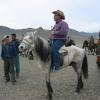Land and resource loss, and change and fragmentation in the rangelands have increased dramatically in recent years due to both ‘external’ and ‘internal’ influences, including a lack of recognition of land- and resource-ownership rights, poor land-use planning, and privatization processes. These influences are having significant negative impacts on millions of rangeland users, including pastoralists and hunter-gatherers who depend upon rangelands for their food and livelihood security, as well as affecting national economies, peace and security. Predicted changes in climate highlight the importance of maintaining livelihoods, such as pastoralism that are able to adapt to and have a history of coping with aridity and unpredictable climatic events and stress. The comparative advantage that rangelands and rangeland peoples have in this regard is increasingly being compromised by their loss of access to resources and land.
From January 29 to February 9, 2018, International Land Coalition’s Rangelands Initiative and Land Portal Foundation will co-facilitate a dialogue onexperiences of making rangelands more secure for local rangeland users. This will focus on the challenges faced by rangelands and rangeland users, good practice, and ways forward and bring together the perspectives of governments, international agencies, communities, academics, donors, NGOs and CSOs, private sector and others. The dialogue will improve the understanding of rangelands and rangeland users and current dynamics, trends and challenges; as well as opportunities for making rangelands more secure through good practices and new opportunities. It is also anticipated that the dialogue will strengthen the ILC Rangelands Initiative multi-stakeholder platform and others, and provide clear strategic direction for further engaging on rangelands globally and nationally.
This dialogue will contribute to an improved recognition of the rights of rangelands users by increasing understandings of current trends and challenges faced by them, sharing good practice in making rangelands more secure, and discussing opportunities for adapting these good practice and/or scaling up. The primary objectives of the dialogue are to:
- Consolidate the challenges faced by rangelands and rangelands users globally, including commonalities and differences of these, their contexts, and their outcomes in order to develop a clear picture of the issues.
- Share good practice experiences, innovations and initiative, and lessons learned on making rangelands more secure for different rangeland users including pastoralists and agro-pastoralists, including both men and women and other social groupings so that others can learn from these and/or to strengthen and/or improve them.
- Identify and/or strengthen pathways at different levels of engagement for makingrangelands more secure including collaborations between multiple stakeholders.
Anticipated outputs
- Consolidation of challenges faced by rangeland users globally.
- Synthesis of good practice experiences and lessons learned on making rangelands more secure.
- Synthesis of discussions related to areas of convergence and disagreement between different stakeholders.
- Identification of stronger pathways to engage as a multi-stakeholder platform to make rangelands more secure.
Discussion questions
1. What land-related challenges are rangelands and rangeland users facing globally?
- What trends of land use change are being seen in different parts of the world? What are the causes of these? What are their impacts on different rangeland users?
- To what degree are local rangelands users including often marginalised groups such as women and pastoralists involved in decisions over these changes?
- Where are the hotspot areas of land use conflicts, and what are the causes of these conflicts?
2. What are some good practice examples, experiences and lessons learned of making rangelands more secure?
a. What are the example of enabling policy and legislation that supports the rights of local land uses to rangelands? Are they successful? And if so, what are the main elements of success?
b. What initiatives exist that have secured rights of local rangeland users to land and resources and why have these succeeded where others have not?
c. What initiatives exist that have improved land use planning processes resulting in more effective use of land and reconciliation of differences between land users?
d. To what degree are these initiatives participatory and inclusive ensuring that all stakeholders are involved including often marginalised groups?
e. What new technology has been used to make the securing of rangelands more effective and efficient?
f. What examples exist of initiatives that have successfully resolved land use conflicts and what lessons can we learn from these for further application?
3. How can we develop strong pathways for engagement as a multi-stakeholder platform?
a. What are the key pathways to securing rangelands for local rangeland users at different levels?
b. How can different stakeholders better connect, mobilise and influence in order to make rangelands more secure?
c. How can working together add value to working individually? An example being the International Year of Rangelands and Pastoralists.
d. What are the key opportunities for working as a multi-stakeholder platform in order to make rangelands more secure?


























